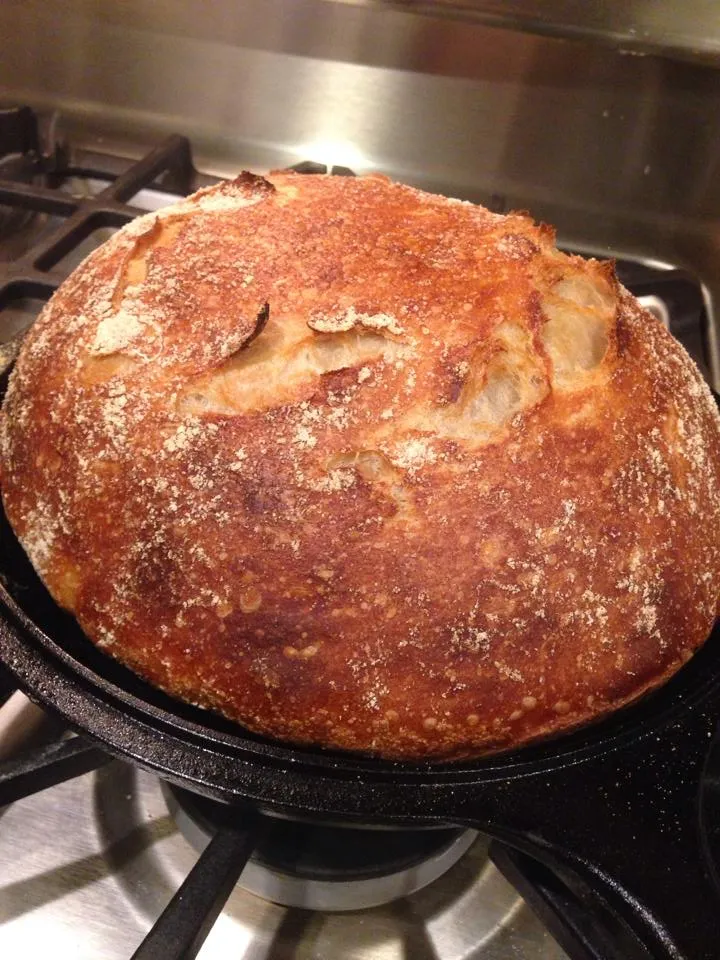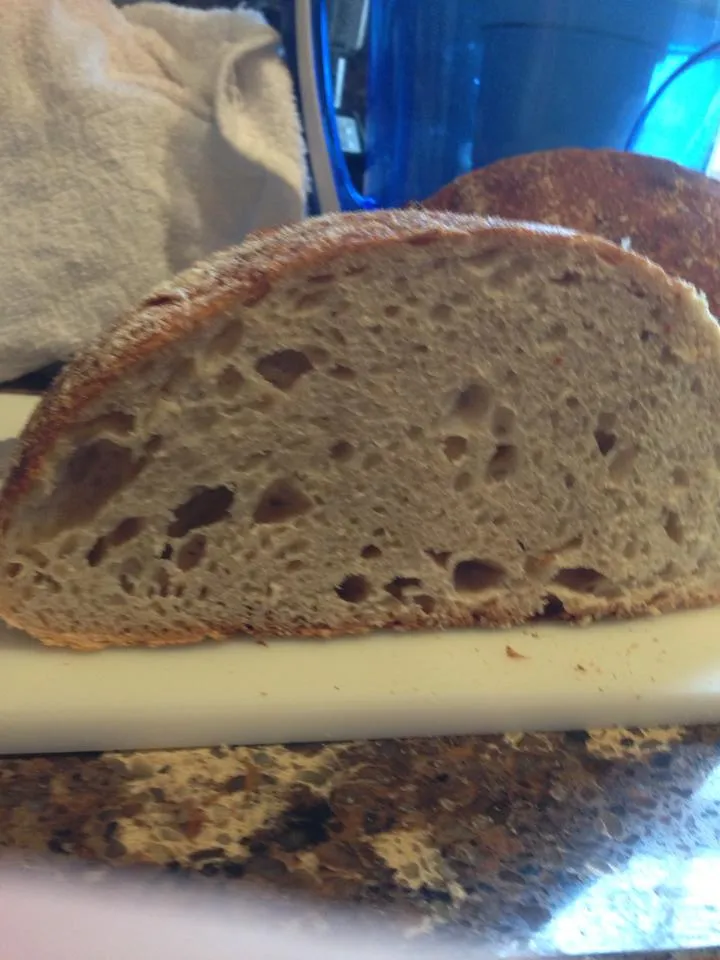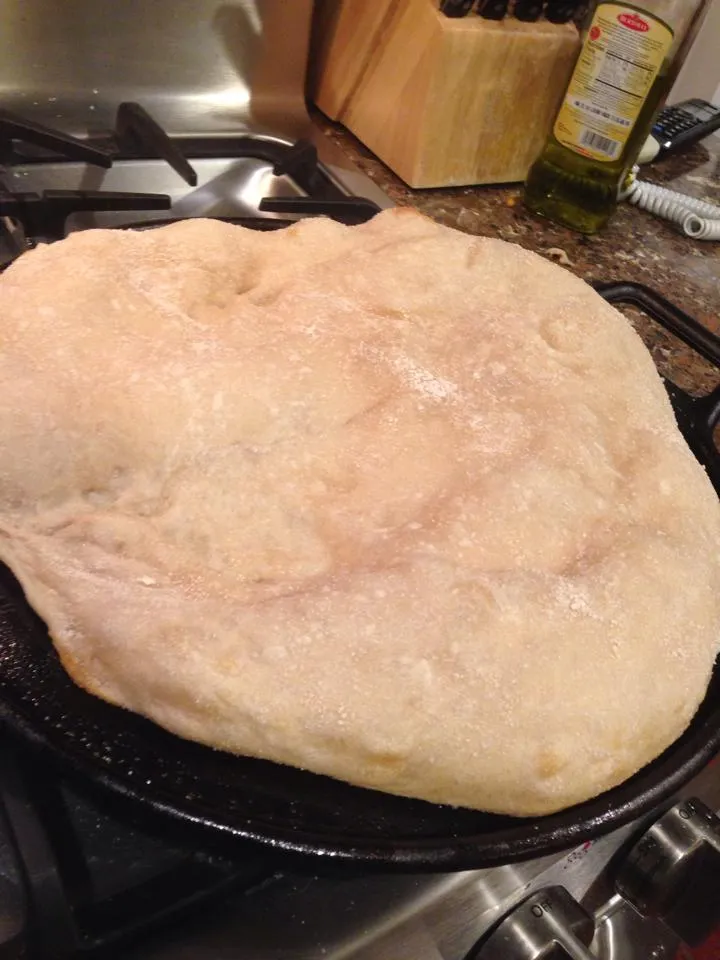The baking bug bit me about six weeks ago. Started with banana bread, baked two loaves of yeasted bread in my lodge cast iron loaf pans, moved on to making pizzas and then tried my hand at sourdough -- ciabatta, english muffins and english muffin bread and even a "basis sourdough loaf" that I read about in a Jane Harrison's "An EasyGuide to Sourdough" which contains weird volume measurements: 2 cups of flour, 1.5 cups starter, 3/4 tsp of sale. No added water in the recipe but always needed to add water in order to form a dough.
I read a lot about the no-knead breads and wound up buying Tartine. I read the directions for the basic loaf about 7 times before making it, but there is no substitute for experience.
First, after making the leaven, I forgot that I only needed 200grams of it, and used the entire amount made. I am sure I am not the first person to do this, as the recipe is, shall I say, a bit wordy and could use with some bold print here and there.
After I mixed the dough and hunted around for a place to pour it, I kept wondering how the heck it could be put in a small container Let me tell you, it was a LOT of dough with the extra 200 grams of leaven! But I would be damned if I was going to throw away all of that flour, so once I figured out what I did, I just shrugged and carried on. The dough was very heavy, but it was not sticky at all, at least by the time the first turn was there.
I have to say the recipe is not well written. Or at least, i did not find it so. He says the bulk rise should be for 3-4 hours and that he turns the dough ever 30 minutes for the first two hours. Well, that leaves 1-2 hours with no directions. Do I turn, do I not turn? He mentions that by hour three the dough should feel pillowy when turning but doesn't say how often one is turning by this point.
In any case, I figured if peasants can do it, I don't have to do everything exactly the way anybody else does it and hopefully it would come out passable.
I found the pictures to be very well done but very poorly situated. It would have been a lot better, in my opinion if the walls of text were separated by the appropriate pictures instead of random pictures interrupting the text. I may be too harsh here and maybe they are in exactly the right place, but I feel like I would benefit immensely by photocopying the chapter, pictures and all, and rearranging the photos to merge into the text better.
Anyhow, after shaping (pretty much did it wrong, didn't cut flip and fold, but instead, cut flipped and shaped into a ball/disc) i put the dough into the mixing bowl, lined with a tea towel/bar mop sprinkled with the 50/50 rice/wheat flour (I made the rice flour in my blender), let it rise at room temperature 70 degrees or so, and then dumped one loaf into the skittle -- forgot to score it, took the dutch oven out of the oven, covered the skittle and baked for the appropriate time, removed and continued the bake.
No, bread did not explode. I used the other portion of the dough to make a pizza crust. What I found AMAZING was the elasticity of this dough. It stretched into an enormous pie immediately and without any effort.
Anyway, the pictures show the final product, and they tasted quite good. The bread was cut the following day and the pizza finished off the following day. I need a peel, as what I did was really dangerous and I won't do it again that way in the future...
Loaf uncut:

Bread sliced:
Pizza dough pre-baked:


- David Esq.'s Blog
- Log in or register to post comments
Hope you didn't mess with the dough after the first 2 hours because the other 2 are for reading and relaxing and leaving the dough to its own devices:-) It all looks fine and dandy in the end. If you use parchment paper to plop the dough on then you can use a sheet of flat cardboard or a cutting board for a peel - did that for years the dough doesn't know and it is a safer way to transfer dough.
I really like that puffy pizza! The bread is pretty good too. Welcome and happy baking
Actually, I believe I turned it once at the end of the third hour. I am nearly certain (though don't have the book with me) that he references turning the dough in the third hour, though, I assume I could have obtained an airier crumb if I had left it alone.
I did not note this in the original post, but the following morning I made the recipe again, and this time I measured the leaven correctly instead of using it all. I also scored the loaf. Having made the leaven in the morning, I left the dough out on the porch where it was cold (maybe too cold...) and it did not rise all that much over night. And I may have divided the dough unevenly.
I wound up with a small loaf and a large pizza -- not as puffy as the other one, but not cooked the same way either. This pizza was cooked in my cast iron griddle but I did not cook it long enough (nor cook it on a preheated griddle, as I do not have a peel). What I find remarkable is how easy this dough stretches for pizza. I follow his recommendation to press down around an inch inside the perimeter to make the crust, and when I lift the dough from underneath (slipping my hand past the indent) the whole pizza practically stretches to its final size before I can rotate the dough.
As I still had 1/2 a giant loaf, placed the new bread in a freezer bag and put it in the freezer. So I have no idea what the crumb looks like.
So, this time I again dumped the entire leaven into the water (it floated nicely), but then remembered I was only supposed to use 200 grams of it, so I scooped out enough to leave 200 grams in, and followed the recipe to a "T", sort of.
First, despite what others have said, the author definitely contemplates "turning" the dough more than 4 times (i.e., every 30 minutes the first two hours), and so I turned at the end of the third hour for a total of 5 turns.
Second, I forgot the score the loaf again. This time, I realized it less than a minute after I put the bread in the oven. So I took the pans out, removed the top and then slashed away using my chef's knife. Not very elegant, I admit. The cuts were not deep at all and I do not know if they accomplished anything, but I was not unhappy with how the bread shaped up, and definitely not unhappy with how it tasted.
While I have yet to hear my bread sing, this loaf sounded hollow when tapped, and the crust was crisp rather than overly chewy. It still has a chew, but it also had a light crunch.
Like bakers before me, I am flummoxed by cutting a round loaf. I tried the herringbone cutting technique but this just yields two surfaces exposed to the air, and it is impossible to stand it up "on end" so that the cut end is not exposed to the air. So this time around I am just slicing it normally (I stand the loaf up on edge because it is easier to cut down with the knife cutting through less bread). Made a very tasty peanut butter sandwich with it. I did not do an overnight rise after shaping the loaf (although the second half DID rise overnight in the fridge, it is being used for pizza tonight) and it came out with less sour flavor, but still a hint of the sour. Overall, I am very pleased with the taste, crumb, and look.